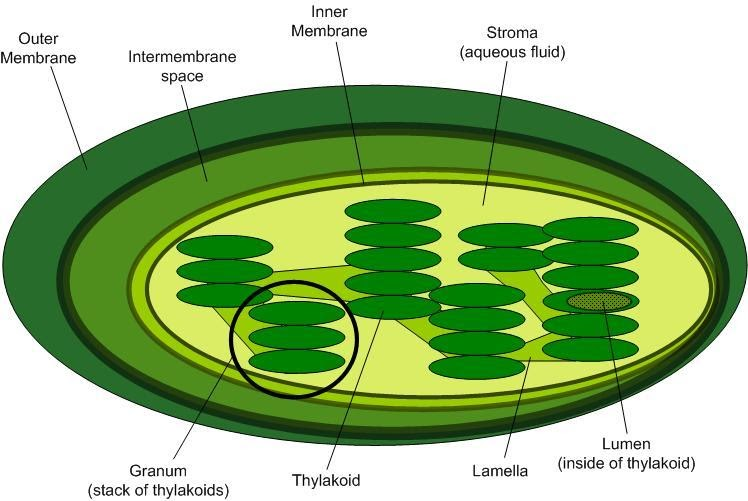
Which cells contain chloroplasts?
Answer
510.9k+ views
Hint: Chloroplasts are usually found in green plants and algae. Chloroplasts are also found in photosynthetic tissues that do not appear green in color, such as brown blades of giant kelp or the red leaves of certain plants. chloroplast is a pigment based on plastid types.
Complete answer:
Chloroplasts contain chlorophyll and carotenoid pigments that are necessary for photosynthesis in light energy.

Majority of the chloroplast of green plants are found in the mesophyll cells of leaves. The organelles are lens-shaped, oval, spherical, discoid or even ribbon-like and vary in length from \[5 - 10{\text{ }}mm\]and in width from\[2 - 3{\text{ }}mm\]. Their number varies from \[1\] per cell as example – Chlamydomonas, green alga.
Like mitochondria chloroplasts are also double membrane organelle. One of the membranes is the inner membrane which is less permeable. The space limited by the chloroplast's internal membrane is referred to as the stroma. A number of organized flattened membranous sacs called as thylakoids are present inside the stroma. Thylakoids are arranged in stacks like the piles of coin shaped known as grana. Also, there are flat membranous tubules called the stroma lamellae which connects the thylakoids of different grana. Chloroplast stroma contains a wide range of enzymes necessary for carbohydrate and protein synthesis. The membrane of thylakoids is enclosed by a space which is called lumen.
The stroma also contains small, double stranded DNA molecules and ribosomes. The ribosomes of chloroplasts are smaller \[70s\] than the cytoplasmic ribosomes \[80s\]. As we discussed that chloroplasts are required for photosynthesis mechanisms beside providing pigment to plants, now let us see the machinery of photosynthesis and how it works.
The thylakoid membrane houses chlorophylls and different protein complexes, including photosystem I, photosystem II, and ATP synthase which are specialized for light-dependent photosynthesis. Chloroplasts have their own DNA often known as DNA. Chloroplast DNA is not associated with true histones in red algae, similar proteins that tightly pack each chloroplast.
Note:
Chloroplast DNA nucleoids in the primitive red algae are clustered into the center, while the nucleoids are spread over all stroma in green plants and green algae. Not all cells in a multicellular plant contain chloroplasts. The plant cells which contain chloroplasts are mostly parenchyma cells but also collenchyma tissue have some chloroplasts. A plant cell which contains chloroplasts is typically called a chlorenchyma cell.
Complete answer:
Chloroplasts contain chlorophyll and carotenoid pigments that are necessary for photosynthesis in light energy.

Majority of the chloroplast of green plants are found in the mesophyll cells of leaves. The organelles are lens-shaped, oval, spherical, discoid or even ribbon-like and vary in length from \[5 - 10{\text{ }}mm\]and in width from\[2 - 3{\text{ }}mm\]. Their number varies from \[1\] per cell as example – Chlamydomonas, green alga.
Like mitochondria chloroplasts are also double membrane organelle. One of the membranes is the inner membrane which is less permeable. The space limited by the chloroplast's internal membrane is referred to as the stroma. A number of organized flattened membranous sacs called as thylakoids are present inside the stroma. Thylakoids are arranged in stacks like the piles of coin shaped known as grana. Also, there are flat membranous tubules called the stroma lamellae which connects the thylakoids of different grana. Chloroplast stroma contains a wide range of enzymes necessary for carbohydrate and protein synthesis. The membrane of thylakoids is enclosed by a space which is called lumen.
The stroma also contains small, double stranded DNA molecules and ribosomes. The ribosomes of chloroplasts are smaller \[70s\] than the cytoplasmic ribosomes \[80s\]. As we discussed that chloroplasts are required for photosynthesis mechanisms beside providing pigment to plants, now let us see the machinery of photosynthesis and how it works.
The thylakoid membrane houses chlorophylls and different protein complexes, including photosystem I, photosystem II, and ATP synthase which are specialized for light-dependent photosynthesis. Chloroplasts have their own DNA often known as DNA. Chloroplast DNA is not associated with true histones in red algae, similar proteins that tightly pack each chloroplast.
Note:
Chloroplast DNA nucleoids in the primitive red algae are clustered into the center, while the nucleoids are spread over all stroma in green plants and green algae. Not all cells in a multicellular plant contain chloroplasts. The plant cells which contain chloroplasts are mostly parenchyma cells but also collenchyma tissue have some chloroplasts. A plant cell which contains chloroplasts is typically called a chlorenchyma cell.
Recently Updated Pages
The number of solutions in x in 02pi for which sqrt class 12 maths CBSE

Write any two methods of preparation of phenol Give class 12 chemistry CBSE

Differentiate between action potential and resting class 12 biology CBSE

Two plane mirrors arranged at right angles to each class 12 physics CBSE

Which of the following molecules is are chiral A I class 12 chemistry CBSE

Name different types of neurons and give one function class 12 biology CBSE

Trending doubts
Fill the blanks with the suitable prepositions 1 The class 9 english CBSE

Who among the following opened first school for girls class 9 social science CBSE

What does the word meridian mean A New day B Midday class 9 social science CBSE

What is the full form of pH?

Write the 6 fundamental rights of India and explain in detail

Which places in India experience sunrise first and class 9 social science CBSE




